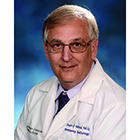Assisting the mature radiologist
Considering that you possess excellent visual recognition skills, I’m certain you noticed there are two pictures of yours truly accompanying this month’s editorial—the old, familiar one of “Young Dr. Stu,” and a new, unfamiliar one of “Older Dr. Stu.”
 Young Dr. Stu was clearly taken a long time ago, and has been used throughout my 15 years or so of service as editor-in-chief of Applied Radiology to help attach a real person to the source of these opinions. That this picture has been used for so long is due in roughly equal parts to: 1) my own laziness to have a new one taken, 2) my disinclination to pay for a new one taken professionally, 3) to the failure of my wife to take a decent digital picture of me, and 4) —no doubt—to some degree of ego sensitivity.
Young Dr. Stu was clearly taken a long time ago, and has been used throughout my 15 years or so of service as editor-in-chief of Applied Radiology to help attach a real person to the source of these opinions. That this picture has been used for so long is due in roughly equal parts to: 1) my own laziness to have a new one taken, 2) my disinclination to pay for a new one taken professionally, 3) to the failure of my wife to take a decent digital picture of me, and 4) —no doubt—to some degree of ego sensitivity.
As it turns out, my august institution recently upgraded its medical school information webpage, which came along with a no-exceptions, no-questions-asked mandate for new pictures of all physicians wearing—what else?—a white hospital coat and tie.
 So I bit the bullet and took advantage of the occasion to update Young Dr. Stu with Older Dr. Stu. As you can see, the new picture shows the dramatic effect of suddenly dumping a bunch of years onto a person. Believe me, that bullet hurt.
So I bit the bullet and took advantage of the occasion to update Young Dr. Stu with Older Dr. Stu. As you can see, the new picture shows the dramatic effect of suddenly dumping a bunch of years onto a person. Believe me, that bullet hurt.
All kidding aside, the occasion of updating my headshot triggered some serious thoughts and reflections on the importance of helping mature radiologists (and I do include myself in that category) who are facing the approaching prospect of retirement.
The fact is, diagnostic imaging is a challenging specialty that requires superfast cerebral processing, a great memory, sharp eyesight, and the capacity to hang out in a dark room all day and deal with insistent, occasionally aggressive people who always want your opinion in very few seconds, even before a study in question is available. Add evening and night call coverage with rising study demand, greater time pressure, and longer recovery times for older radiologists, and the risk of psychological and physiological problems are considerably amplified. It’s no wonder radiologist burnout is pretty common.1 Development of physical illness, substance abuse, or psychological difficulties are also more likely to occur with advancing age.2
In the cognitive arena, ability begins to decline at around age 25, implying that most practicing radiologists have been coping with such declines successfully ever since residency.2 Short-term (working) memory begins to drop at about the same time, but accelerates with advancing age. Multitasking also becomes more difficult with age, and reasoning speed decreases.2 Hearing, strength, flexibility, and endurance decline; the burden of illness and risk of disability increase over a person’s lifetime.
Vision is the most common physical challenge for radiologists, with cataracts coming in as the top problem for aging radiologists.3 Among persons older than 60, 96% exhibit reduced transparency of the eye lens, and the retina receives only a third as much light as it does in a 20-year-old. The ability to adapt to glare and darkness is reduced with age.2 Aging is also associated with changes in image processing by the cortex.
As of 2014, 36,000 radiologists were practicing in the U.S., 7,000 of whom were aged 56 to 65 and working fulltime. The average retire>ment age for a radiologist had dropped from 70 to 64.3 If they can retire, most radiologists in the senior age group are probably considering such questions as when and how to retire. In the meantime, many are likely trying to develop strategies to not appear too old, especially intellectually, and to continue to handle their responsibilities at a high level of competence.
Potential solutions for maturing radiologists
What can be done to help ease the transition for mature staff before they rupture a temporal lobe or, more realistically, begin taking five minutes to read a normal chest radiograph or even potentially make interpretation mistakes that can hurt patients?
For starters, I believe verifying radiologist competence at some pre-selected age like 55 or 60 is important, whether by using on-going quality assurance methods or more focused evaluation. Making sure the radiologist is comfortable handling the workload and case mix, and adjusting coverage hours and case volume to a level they can better cope with is crucial. That often means part-time service with commensurate pay/benefit adjustments.
Simply maintaining the status quo and failing to recognize the eventual and progressive impact of aging on performance can amplify the difficulties and lead to early retirement and loss of a potentially valuable resource. (Of course, there may be a difference of opinion about when a staff member should retire, but that’s another issue.)
Adjusting work responsibilities
Decreases in work efficiency or changes in coverage provided by the aging radiologist can certainly place greater clinical burdens on younger co-workers who may not be willing to assume more on-call to support the senior member.4 This factor should be addressed and additional direct clinical coverage provided when possible. Hopefully, all physician staff will appreciate that they are also likely to be in the same job situation in the future and be willing to increase their efforts for an associate who cannot handle the same level of clinical demand.
I recall as a young whippersnapper resident in my department that some of the senior radiologists often arranged their own circumstances to reduce their work burden. Several moved next door to the Veterans Hospital, where the pace was much slower, you could decline studies, the day was strictly 8-to-4, there were seldom medical students or residents to teach, and university staff covered after hours. Typically, the older radiologists would also narrow their scope of practice. One 80-year-old radiologist who really looked ancient only read chest radiographs and barium studies. No one competed with him for the fluoroscopy cases so he was the de facto expert. I don’t know if he was really any good at them, since the films were never on display and the veterans never complained. Another radiologist took advantage of waking very early so the night resident usually read out cases with him at 5 a.m. He was done by early afternoon and either napped in his office or went home. Another faculty member just constantly yelled at and intimidated people, thus compensating for any performance insecurity he may have felt related to his age. Going part-time or working from home are probably the most appropriate adaptations available today.
Helping maturing radiologists with financial issues
At the appropriate time, the radiologist approaching the end of his or her radiology career should have administrative and physician department leaders address their immediate and long-term interests in designing a planned separation from the department. Under the best circumstances the department should offer the resources, possibly through the financial service managing their retirement plan, to review major financial issues in retirement with the faculty member beyond what is typically covered by Human Resources. Also, providing the physician with professional assistance to explore alternative fulfilling activities in partial or complete retirement will help smooth a typically difficult transition.
While the mature radiologist may no longer be as dynamic a contributor to a practice, he or she still possesses a wealth of experience and knowledge that can benefit trainees and staff. Just as it is wise to monitor, guide and promote development of a new radiologist, it should also be reasonable for department leadership to match aging staff members’ work demands to their capabilities and assign alternative non-direct clinical responsibilities to “fill the gap.” Assistance in making the transition to part-time or fulltime retirement on select issues should also be a responsibility of the department. The performance of the older radiologist may require somewhat more formal monitoring to verify adequate skill level in direct clinical care.
But ultimately it can result in a win-win for everyone.
References
- Royal College of Radiologists. The older radiologist. https://www.rcr.ac.uk/clinical-radiology/service-delivery/sustainable-future-diagnostic-radiology/older-radiologist Accessed November 9, 2016.
- Proval C. The third rail: measuring and managing physician productivity. Radiology Business Journal. 2008.
- http://www.radiologybusiness.com/topics/business/third-rail-measuring-and-managing-physician-productivity. Accessed November 9, 2016.
- Dechter F. Strategies for coping, retirement planning critical to the aging radiologist. RSNA Daily Bulletin. 2014. http://rsna2014.rsna.org/dailybulletin/index.cfm?pg=14wed03. Accessed November 9, 2016.
- Jones SB. Six options for retiring radiologists. Diagnostic Imaging. 2013. http://www.diagnosticimaging.com/practice-management/six-options-retiring-radiologists. Accessed November 9, 2016.
Citation
SE M. Assisting the mature radiologist. Appl Radiol. 2016; (12):4-6.
December 9, 2016